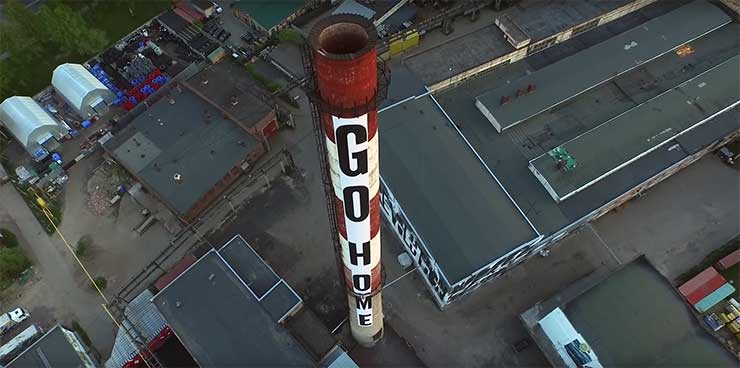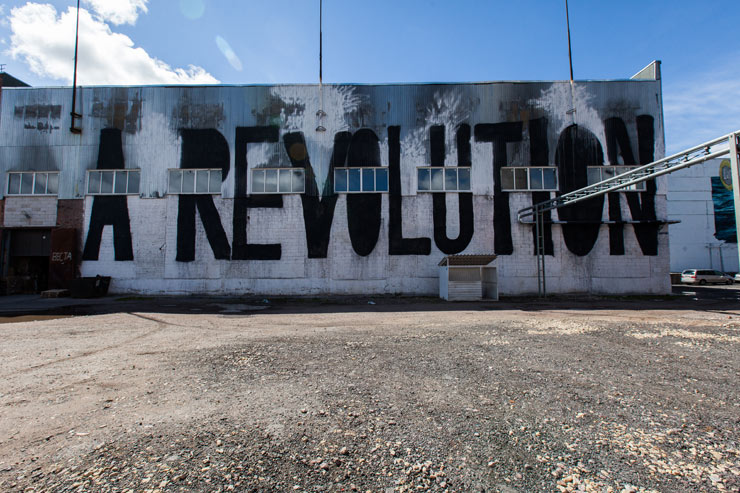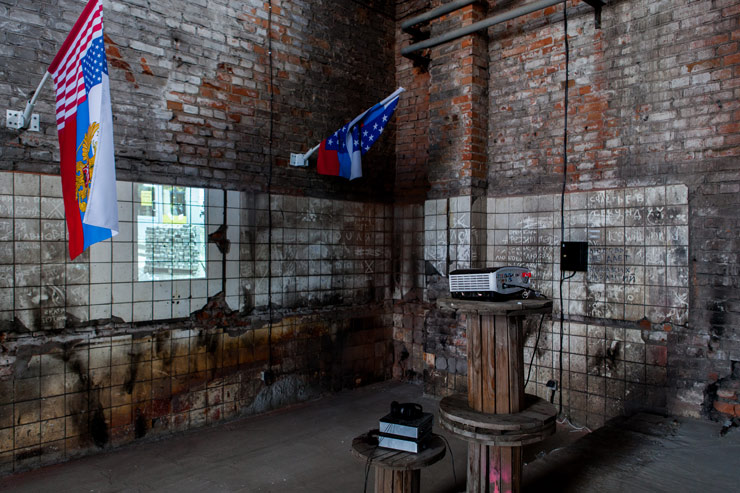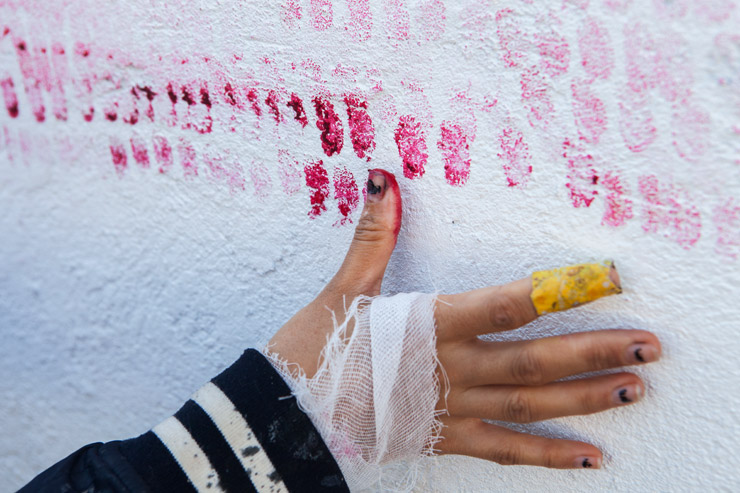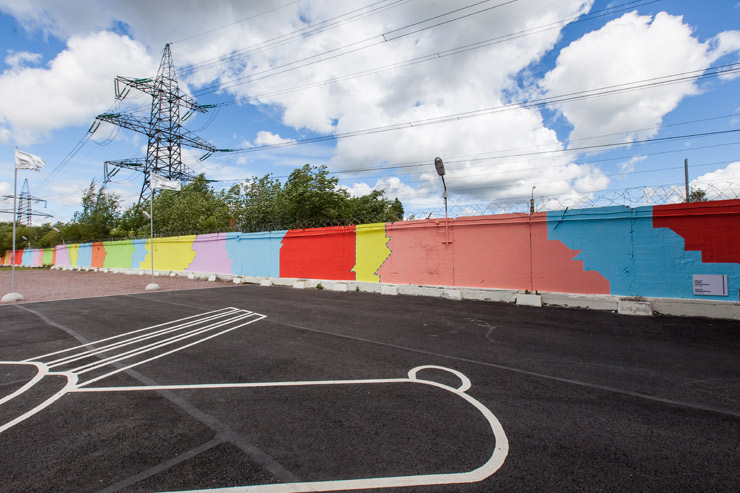Rafael Schacter Takes a More Nuanced Approach to the Migration Crisis
Commerce and technology have been eroding traditional constructs of the borders and boundaries, especially in the age of the Internet, satellites, transnational banking and trade agreements that create governing bodies that openly dismiss national sovereignty, integrity, identity, aspirations. Borders and boundaries are contested, guarded, or disregarded at will; open to international capital, porous to immigration, hardened by armies.
Daily they are in the headlines: Trump’s plans to build a wall along the US-Mexican border, Syrian war refugees immigrating across European borders, Israel and Palestine’s ongoing land and settlement disputes, even maritime territorial claims of China and the Phillipines in the South China Sea that were ruled upon yesterday – all reveal clues to our historically complicated relationships and geo-political perspectives.
Art to the rescue!
A current show mounted by primarily urban artists under the direction and curatorial vision of Rafael Schacter in Saint Petersburg, Russia takes on a thin, rich slice of this story; a conceptual examination of borders and boundaries from the perspective of migration. With global forced displacement breaking all records in 2015 at 60 million people according to the UN we clearly need to re-examine these constructs and decide what purpose/ which people borders are serving.
Sorry, we’re using terms interchangeably, which Schacter will correct us on. Toward that end, we are pleased today to present Mr. Schacter, an anthropologist, researcher of street art, author, and lecturer, here on BSA to share observations and experiences from his most recent project, a fascinating show at the Street Art Museum (SAM) called Crossing Borders /Crossing Boundaries. Our thanks to the artists, only a small number of whom we are able to present here, as well as to the museum for sharing their talent and resources. A full list of the participating artists is at the end of the article.
——————————–
~ from Rafael Schacter
In May of this year, I spent nearly four weeks in Saint Petersburg curating a large scale exhibition at the Street Art Museum (SAM). The Museum, set in a functioning factory on the edge of the city, is a mammoth site. The first plastics factory in the Soviet Union, the site became partially abandoned in the 1990s after the collapse of communism, and has since been taken over and partly given over to this new museum. Containing huge outdoor and indoor spaces, the museum is truly a dream location to work.
For the summer exhibition this year, we decided to focus on what has been termed the Migration Crisis. Rather than tackling this head on, however, something that I feel can often be crass and exploitative, something that I feel can often be seen to be utilizing peoples’ hardships for artistic ‘gain’, I sought to provide a concept that could explore the theme from a more nuanced angle.
The title of the exhibition, Crossing Borders / Crossing Boundaries, thus attempted to explore the differences between these two terms; words which are often used interchangeably, but are in fact quite distinct.
Utilizing the work of renowned sociologist Richard Sennett, borders were hence posited as zones of high organic interactivity and development, engaged, permeable spaces such as the zones between the land and the sea in which different species thrive, intermix and exchange. In contrast however, boundaries were understood as guarded, impenetrable locations, locations, for example, like the territorial perimeters of creatures such as lions or wolves.
Focusing on these differences, on the fertility and vibrancy of the border compared to the sterility and aridity of the boundary, we then commissioned 20 artists from around the world to produce works on this theme.
Working with artists from a background of street art as well as contemporary art, with video artists and photographers, muralists and artivists, the exhibition is thus truly multi-media and multidisciplinary. I was beyond impressed with the results, all the artists bringing an amazing set of ideas to the table and delivering them in the most fantastic of ways.
We had over 5,000 people come to our launch on May 14th, as well as a huge international conference on the topic of migration taking place in the museum on the same day. Living, working, eating and sleeping in the factory with all of the artists over the entire period of production was tough, to say the least. However the energy was unrelenting, with the artists and the whole team at SAM working without rest to deliver this incredible project.
I’m super proud of what we achieved, to both sensitively and critically explore this theme, to not just provide the traditional liberal consensus positionality but rather to challenge people’s thoughts and ideas on this topic. Who knows what effect it will have, if any. But I hope that the project can push people to think about the topic in a more nuanced rather than binary way.
Following the video are a few of the artists and their work for Crossing Borders / Crossing Boundaries
SpY. Street Art Museum (SAM). St. Petersburg, Russia. May 2016. (photo © Evgeniy Belikov)
SpY
Go Home / Crisis / Basket
- Printed banner on chimney / Acrylic paint on oil barrels / Basketball hoop and backboard on containers, acrylic paint on asphalt
SpY’s deceptively simple yet conceptually ingenious interventions focus on the upturning of spatial and societal norms. Using irony and humour to create a dialogue with the viewer, SpY attempts to impress multiple readings onto a space, re-presenting it as a “frame of endless possibilities”.
His set of works here follow this method precisely. In particular, his giant work Go Home, at first an apparently aggressive, deeply antagonistic phrase (to put it mildly), plays with the variety of meanings that this expression can contain: the very ability to go home, for example, to return back to the place of one’s family, one’s birth, one’s life, is the very thing that most immigrants desire but simply cannot undertake (whether due to war or famine, economic or ecological pressures). To be able to go home is thus a privilege that not all of us have.
As with his famous method of renegotiating the set rules of sporting activities, provoking, as he says “disorder and chaos through context and content”, SpY’s works do not simply invert or subvert their spaces but playfully distort them. They “misuse” their environments to show the latent possibilities that lie within.
SpY. Street Art Museum (SAM). St. Petersburg, Russia. May 2016. (photo © Evgeniy Belikov)
SpY. Street Art Museum (SAM). St. Petersburg, Russia. May 2016. (photo © Evgeniy Belikov)
SpY. Street Art Museum (SAM). St. Petersburg, Russia. May 2016. (photo © Evgeniy Belikov)
Filippo Minelli. Street Art Museum (SAM). St. Petersburg, Russia. May 2016. (photo © Evgeniy Belikov)
FILIPPO MINELLI
Untitled / A Revolution Nobody Cares About
- Scaffold, laminate photographic prints, flags, and spray paint and acrylic on containers / Acrylic paint on wall
Fillipo’s installation for Crossing Borders / Crossing Boundaries explores different border zones throughout the globe. From the sea border of North and South Korea to that of Mexico and California; from Morocco and Mauritania to Cambodia and Vietnam; from the invisible border between Northern Mali and the disputed territories of the Azawad; to abandoned NATO bunkers at the Belgian Dutch border, these images present us with some of the most politically fraught locations on the planet which, somehow, contain a strangely alluring beauty. Alongside this, Filippo presents a series of Whatsapp conversations documenting his personal struggle to gain entry into Russia for this exhibition: a series of Kafkaesque scenarios in which he was sent from location to location in a seeming test of his resistance. The installation as a whole can be seen to bring together Filippo’s joint obsession with political, industrial and internet aesthetics.
His mural, A Revolution Nobody Cares About / Nobody Cares About a Revolution speaks, quite loudly, for itself.
Filippo Minelli. Street Art Museum (SAM). St. Petersburg, Russia. May 2016. (photo © Evgeniy Belikov)
Filippo Minelli. Street Art Museum (SAM). St. Petersburg, Russia. May 2016. (photo © Evgeniy Belikov)
Filippo Minelli. Street Art Museum (SAM). St. Petersburg, Russia. May 2016. (photo Evgeniy Belikov)
Kirill KTO. Street Art Museum (SAM). St. Petersburg, Russia. May 2016. (photo © Evgeniy Belikov)
KIRILL KTO
Incomprehensible
- Acrylic and spray paint on wall
Kirill’s work for Crossing Borders / Crossing Boundaries arose through his correspondence with curator Rafael Schacter. Focusing on the barrier of language and the complexity of translation, the work is about the impossibility of understanding and the unwillingness to understand. As KIRILL says “I understood only a small percentage of what we discussed and so decided to make this the heart of the work”. It is thus the borders and boundaries of language that KIRILL takes aim. As he continues “there are two borders of misunderstanding: you see unfamiliar letters and you do not understand everything completely. Signifier and signified become equally incomprehensible. Or even it’s a familiar language, but still it is not clear”. Kirill’s work, although colourful and bright, is in fact the image of alienation. The image of the migratory and the incomprehensible.
Gaia . Mata Ruda. Street Art Museum (SAM). St. Petersburg, Russia. May 2016. (photo © Evgeniy Belikov)
GAIA & MATA RUDA
If Capital Can Move So Freely Why Can’t Bodies?
- Acrylic and spray paint on wall
Gaia and Mata Ruda have produced a monumental work for Crossing Borders / Crossing Boundaries, a work which functions in the classical tradition of political muralism. Using imagery from the filmmaker Marc Silver and photographers Jonathan Hollingsworth and Alex Kurunis (both of whom show other work within the exhibition itself), Gaia and Ruda present us with an assemblage of figures and artefacts which together convey a dense narrative about contemporary migration. Including individuals and stories from the borders of the USA and Latin America as well as Africa and Europe, the artists also produced a group portrait of three Uzbekistani employees at the factory who work and live in the very site where the mural exists.
The story Gaia and Mata tell is one of inequality and injustice, a story of the imbalance of our contemporary global system. Yet within this it contains hope and strength, the strength of the individuals who strive to fight these inequities on a daily basis.
Gaia . Mata Ruda. Street Art Museum (SAM). St. Petersburg, Russia. May 2016. (photo © Evgeniy Belikov)
Nano4814. Street Art Museum (SAM). St. Petersburg, Russia. May 2016. (photo © Evgeniy Belikov)
Nano4814
Untitled
- Acrylic and spray paint on wall
Nano4814’s half-abstract, half-figurative mural for Crossing Borders / Crossing Boundaries demonstrates the strangely discomforting yet visually arresting style which we can now instantly recognize as his own. Frequently focusing upon the apprehension he has with his own work, Nano’s characters can often be seen to be in states of tension or strain (both literally and metaphorically), an angst reinforced by their compressed captivity within their sites. Moreover, his use of brick-walls, barriers, and wooden shards, symbols that act as leitmotifs throughout his work, play with the idea of boundaries as objects that encourage intrusion and trespass: Like masks, these borders both suggest and occlude a veiled truth, hinting whilst hiding, implying yet escaping. It is thus the very limitation that enables us to venture beyond.
Brad Downey . Igor Posonov. Street Art Museum (SAM). St. Petersburg, Russia. May 2016. (photo © Evgeniy Belikov)
BRAD DOWNEY & IGOR PONOSOV
Double Yippie Hollow Super Power
- Slides, DIA projector, flags, photographs, socks, coins, drawings in collaboration with Clemens Behr, SPY, Paco, and Fillipo Minelli, computer guts, digital prints, plastic, wood, plexi-glass, mounting hardware, sound installation, radio, headphones, cables, paint, chess set, soviet fabric, and industrial spools.
Double Yippie Hollow Super Power is a joint project between artists Brad Downey from the USA and Igor Ponosov from Russia. Taking inspiration from the parlor game “cadavre exquis” or “exquisite corpse” (a method by which a collection of words or images is collaboratively assembled), the pair have sought to combine the varying national symbols of their home nations into a new, exquisite set of iconic forms. The “unity of the opposites” that they have created – utilizing objects such as flags, coins, and anthems – plays with the sacrality of these national symbols, the almost divine status that they contain. Moreover, it alludes to the strangely intimate relationship that the two countries are entwined in. Whilst apparent opposites, common enemies, both locations create their identity through their connection with the other: the objects Downey and Ponosov have thus created contain both a critical and playful edge. They ridicule the stereotypes of both themselves and each other in the same moment.
Brad Downey . Igor Posonov. Street Art Museum (SAM). St. Petersburg, Russia. May 2016. (photo © Evgeniy Belikov)
Brad Downey . Igor Posonov. Street Art Museum (SAM). St. Petersburg, Russia. May 2016. (photo © Evgeniy Belikov)
Brad Downey . Igor Posonov. Street Art Museum (SAM). St. Petersburg, Russia. May 2016. (photo © Evgeniy Belikov)
Jazoo Yang. Street Art Museum (SAM). St. Petersburg, Russia. May 2016. (photo © Evgeniy Belikov)
JAZOO YANG
Dots / Painting Blocks
2016, Korean ink on wall / Found objects, cement, and acrylic paint on wooden palletes
Jazoo Yang’s Dots series originates from her work in her native Korea, in particular within areas of the city going through the process of redevelopment. Using traditional Korean ink, and solely using her thumbprint (a marking used as a signature on important documents), Yang’s work sought to bring focus on the increasing amount of “redevelopment refugees” in the city
For Crossing Borders / Crossing Boundaries, Yang has expanded her Dots Series to incorporate the issue of refugees and migrants in Europe and further beyond. Working mainly on her own but also with immigrant workers from the factory itself, Yang discusses their stories, their histories, their existence with these individuals as they mark the wall together. These imprints act as a record of this moment whilst remaining entirely silent.
In Yang’s Painting Block Works, this theme of memory and regeneration continues. Exploring the violent so central to the contemporary city, Yang wants to ask how much we perceive our lives and make independent decisions within these oppressive environments. She aims to bring these problems to the surface through rebuilding them with the materials we so readily abandon, in Korea using objects from deserted houses and buildings, here in Russia using the detritus and ephemera of the factory itself.
Jazoo Yang. Street Art Museum (SAM). St. Petersburg, Russia. May 2016. (photo © Evgeniy Belikov)
Jazoo Yang. Street Art Museum (SAM). St. Petersburg, Russia. May 2016. (photo © Evgeniy Belikov)
Clemens Behr. Street Art Museum (SAM). St. Petersburg, Russia. May 2016. (photo © Evgeniy Belikov)
CLEMENS BEHR
The Final Frontier (Space) / Our House (In the Middle of the Street)
- Laminate doors, wooden pallets, wooden battons, hinges, and acrylic paint / Acrylic and spray paint on wall
Mimicking and playing with their settings through a process of transformative deconstruction, Clemens Behr’s geometric shapes and abstract forms come to distort the viewers’ perspective, merging two and three dimensional spaces in a single plane.
His installation for Crossing Borders / Crossing Boundaries acts as what he terms a “social maze”. Utilising one of the most classic example of borders/boundaries, the common doorway, the work explores the potentially empowering or inhibiting abilities of these structures: as one door opens, another closes, enabling some and disabling others in the same moment. As a participatory sculpture, its visual possibilities become endless. However conceptually it demonstrates how every decision we take effects those around us. Like many of Behr’s installations, this work was produced with what was at hand, in this case the products and detritus of the factory site itself.
Behr’s mural tackles another question however. Playing with the shadows and design of the adjacent fence, with the actuality of space (and time) versus the potentiality of painting, he questions the boundaries of art itself: Can it go beyond reflection to truly generate the new?
Clemens Behr. Street Art Museum (SAM). St. Petersburg, Russia. May 2016. (photo © Evgeniy Belikov)
Clemens Behr. Street Art Museum (SAM). St. Petersburg, Russia. May 2016. (photo © Evgeniy Belikov)
Eltono. Street Art Museum (SAM). St. Petersburg, Russia. May 2016. (photo © Evgeniy Belikov)
Eltono
Random Geopolitical Map / Upside-down Fence
- Acrylic paint on wall / Barbed wire, steel poles, metal fence, laminate warning signs
Eltono’s mural is a reaction to the absurd rationality of national boundaries. As opposed to the natural flow of borders (as can be seen in perhaps the world’s only natural country, Chile), the carving up of the planet’s boundaries happens at right angles: diagonal, horizontal, and vertical lines cutting up the planet into a perfectly linear patchwork.
As such, Eltono has created his own world map using a generative art technique; using a basic randomizer to choose a digit between 1 and 7, the numbers which emerge then come to define both the color of the country and its borders, indicating the direction that each color, and each boundary will thus take.
Unlike his mural, for his fence installation, Eltono presents us with the opposite of the rationality as seen within maps. Rather, he displays a perfectly irrational object, an upside-down fence. For Eltono, however, the inversion of the fence makes it something lighter, not an object that prevents our movement, but a compact object that can be upended “as if the wind had blown it upside down”. As he continues, “it’s not a massive obstacle anymore. A fence that can be flipped is a territory that can be freed.”
Eltono. Street Art Museum (SAM). St. Petersburg, Russia. May 2016. (photo © Evgeniy Belikov)
Merijn Hos. Street Art Museum (SAM). St. Petersburg, Russia. May 2016. (photo © Evgeniy Belikov)
Merijn Hos
Lost in a Dream
- Acrylic and spray paint on wall
Merijn’s mural has a simple, yet vitally important message. His five globes show us the development from a basic binary of black and white to a densely colored, intricate, heterogeneous space. The final image thus shows us a planet in which, as Merijn says, “everything harmonizes. All the colors are there together and they all work and flow seamlessly with each other. Of course borders exist in many ways, but if we take it a step further and forget about the rules and just go with our feeling this is what I think can be understood as the ideal. That we should not be limited by the rationality of borders. Probably a bit of a cliché. But that’s how I see it and feel it”.
Superproject. Street Art Museum (SAM). St. Petersburg, Russia. May 2016. (photo © Evgeniy Belikov)
SUPERPROJECT (JASPER NIENS AND THIJS EWALTS)
Four Zero
2016, High Pressure Laminate installation
SUPERPROJECT, a two-man design operation spearheaded by visual artist Jasper Niens and industrial designer Thijs Ewalts, focus on computational design and digital fabrication, embracing art, architecture, engineering and technology. For Crossing Borders / Crossing Boundaries, they have created Four Zero, a space within a space, a location only accessible through four, tunnel-like entrances. Due to the curvature of the entrances, the visitor is not immediately sure where they will end up. As such, the work is about revealing and concealing, possibility and difficulty; once people enter the space they can either feel locked up and exposed or protected and safe within its embrace.
Tita Salina. Street Art Museum (SAM). St. Petersburg, Russia. May 2016. (photo © Evgeniy Belikov)
Tita Salina
1001th Island: The Most Sustainable Island in Archipelago
2015/2016. Video, trash, fishing net and wood
Tita Salina’s 1001st Island is a work exploring the changing borders and boundaries of Jakarta. A city which is currently sinking between 2.9 and 6.7 inches per year, and which exists mainly below sea level, Jakarta is currently undertaking a huge land reclamation and producing a 32 kilometer sea wall to try and protect its boundaries, a project that will construct 17 new islands and take an estimated 30 years to complete. The installation presented here, a reproduction of an artificial island built by Salina and local fisherman using marine debris and litter, aims to highlight the negative impacts of the project, in particular the fact that the city refuses to fix the causes of its problems — namely, excessive groundwater extraction and inefficient waste management. Salina thus connects the reclamation and land issue with the human waste that plagues the ocean and the future of the traditional fishermen who live and work within this now perilous space.
———————————-
ARTISTS Crossing Borders / Crossing Boundaries.
Alex Kurunis, Brad Downey, Igor Posonov, Clemens Behr, El Tono, Filippo Minelli, Gaia, Mata Ruda, James Bridle, Superproject ( Jasper Niens & Thijs Ewalts, Jazoo Yang, Jonathan Hollingworth, Kirill KTO, Martha Atienza, Merijn Hos, Nano4814, Rob Pinney, SpY, Tita Salina
For more information please go to The Street Art Museum (SAM)
Additional images at beginning of article are stills from video and are ©The Street Art Museum
———————————-
BSA<<<>>>BSA<<<>>>BSA<<>>>BSA<<<>>>BSA<<<>>>BSA<<>>>
Please note: All content including images and text are © BrooklynStreetArt.com, unless otherwise noted. We like sharing BSA content for non-commercial purposes as long as you credit the photographer(s) and BSA, include a link to the original article URL and do not remove the photographer’s name from the .jpg file. Otherwise, please refrain from re-posting. Thanks!
BSA<<<>>>BSA<<<>>>BSA<<>>>BSA<<<>>>BSA<<<>>>BSA<<>>>
Other Articles You May Like from BSA:
Happy Mother's Day in the US and in Mexico too. We praise the work and the love that mothers around the world are giving today and every day, with gratitude and recognition for their shaping ...
It’s a House Party Y'all! With studio apartments in Manhattan now hitting nearly 3K a month the closest thing most Milennials will ever get to a house party in Gotham will be snagging a VCR tape of t...
BSA is in Moscow as curators of 50+ international artists in the Artmossphere Biennale 2018 for its 3rd edition called Street Art Wave. Till the end of the month we’ll working with a stellar cross...
"I could paint a regular parakeet - something pretty - but that's not me and anyway Peter would f*cking like this!" says Belgian Street Artist ROA as he talks about his newest gift from the natural wo...
This week MOMO is in town and we got to see him setting up for his mini show in a bodega, Concrete to Data opened in Steinberg Museum, a cable show about Street Art arrived and was dissed horrib...
 BROOKLYN STREET ART LOVES YOU MORE EVERY DAY
BROOKLYN STREET ART LOVES YOU MORE EVERY DAY